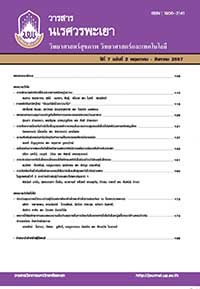การพัฒนาผลิตภัณฑ์ไล่มดจากสารสกัดหญ้าหวาน
Keywords:
หญ้าหวาน, สารสกัด, ผลิตภัณฑ์ไล่มด, Stevia, extract, ant-repellent productionAbstract
หญ้าหวานเป็นพืชสมุนไพรที่ใบให้ความหวานมากกว่าน้ำตาล 15-30 เท่าแต่ไม่ให้พลังงานเพราะมีสาร glycosides ได้แก่ stevioside และ rebaudioside และจากการลงพื้นที่เพื่อศึกษาข้อมูลในแปลงปลูกหญ้าหวาน ผู้วิจัย พบข้อมูลที่น่าสนใจและสอดคล้องกับข้อมูลจากการสัมภาษณ์เกษตรกรผู้ปลูกหญ้าหวานในหมู่บ้านอมลอง อ.สะเมิง จ.เชียงใหม่ ว่า หญ้าหวานเป็นพืชที่มดและแมลงไม่ชอบกัดกิน จึงไม่มีการใช้สารเพื่อกำจัดแมลง ดังนั้น ผู้วิจัยจึงสนใจ ในการสกัดหญ้าหวานและทำเป็นผลิตภัณฑ์ในการไล่มดที่มีความปลอดภัยต่อสุขภาพ การวิจัยครั้ง นี้มีวัตถุประสงค์ เพื่อศึกษาสารสกัดจากหญ้าหวานที่มีฤทธิ์ในการไล่มด และศึกษาประสิทธิภาพในการไล่มดของผลิตภัณฑ์จากสารสกัด หญ้าหวาน โดยสกัดหญ้าหวานด้วยเอทธิลแอลกอฮอล์ 95% เมื่อนำมาระเหยได้สารสกัดแห้งทีมีลักษณะยางเหนียว สีเขียวเข้ม แล้วนำมาทดสอบประสิทธิภาพโดยผสมคลุกเคล้ากับขนม เปรียบเทียบกับขนมที่ผสมน้ำตาล ผลการสังเกต พฤติกรรมมด พบว่า ความเข้มข้นต่ำสุดสารสกัดจากหญ้าหวานที่สามารถไล่มดได้ คือ 5% โดยน้ำหนัก ซึ่ง มีอัตราการ ไล่มดเฉลี่ย 96.33 ± 1.15% เมื่อนำมาทำผลิตภัณฑ์ในการไล่มดได้อย่างมีประสิทธิภาพ พบว่า ในผลิตภัณฑ์ชอล์ก ไล่มดต้องใช้สารสกัดจากหญ้าหวานที่มีความเข้มข้นต่ำสุด 10% โดยมีอัตราการไล่มดเฉลี่ย 97.67 ± 2.08% ในผลิตภัณฑ์น้ำยาป้ายไล่มดและสเปรย์ไล่มด ใช้สารสกัดจากหญ้าหวานที่มีความเข้มข้นต่ำสุดเท่ากันที่ 20% มีอัตรา การไล่มดเฉลี่ย 98.33 ± 0.58 และ 98.67 ± 1.53% ตามลำดับ และพบว่าในผลิตภัณฑ์แบบผงโรยเพื่อไล่มดต้องใช้สาร สกัดจากหญ้าหวานที่มีความเข้มข้นต่ำสุด 10% โดยมีอัตราการไล่มดเฉลี่ย 98.33 ± 2.08% เมื่อนำผลิตภัณฑ์ทั้ง 4 ชนิด มาเปรียบเทียบอัตราการไล่มด พบว่า สเปรย์ไล่มดและน้ำยาป้ายไล่มดได้มากที่สุด รองลงมาได้แก่ ชอล์กไล่มด และผงโรยไล่มดตามลำดับ ดังนั้น จึงสมควรที่จะมีการพัฒนาหญ้าหวานเป็นผลิตภัณฑ์ไล่มดของชุมชนต่อไป
Development of ant-repellent products from stevia extract
Khomkhai Prukesakorn1*, Sutee Nontapa2, Sinth Sarobol3 and Maitree Suttajit3
1*Graduate School, Chiangmai Rajabhat University, Chiang Mai, Chiang Mai Province 50300
2College of Management Sciences, Mae Jo University, Sansai, Chiang Mai Province 50290
3School of Medical Science, University of Phayao, Phayao Province 56000
Stevia is the natural herbs with outstanding qualification as its leaves provide sweetness 15-30 times of sugar sweetness without any calorie. Its sweet substances are glycosides, sush as stevioside and rebaudioside. Besides this, it has another qualification found in the field survey of the plant’s environment in natural stevia plot from stevia farmer’s interview in Omlong Subdistrict, Samueng district, Chiang Mai Province that stevia is the plant that ants and insects do not like. Thus, there is no expense for pesticide. Therefore it is interesting to develop stevia as ant repellant which is safe for health and could be used in daily life. The objective of this research project is to develop stevia extract as ant repellent by its efficiency. The stevia was extracted with 95% ethyl alcohol using alcohol 500 ml per stevia 100 g, and the extract was evaporated obtaining 1 g thick and green extract. Then the extract was tested for its ant-repellent efficiency by mixing it at 5% by wt. with sweet deserts comparing with deserts mixing with sugar. Observing the ants’ behavior from the experiment, it was found that there was no ant in the sweet mixing with stevia at all and that the lowest concentration of the extract that could prevent ant was 5% by weight and its ant-repellent efficiency of 96.33 ± 1.15%. It was also found that the lowest stevia extract concentration in ant-repellent chalk that could repel ant was 10% and its average ant repelling effect was 97.67 ± 2.08% Stevia extract was also used as the sticky paste and spray products, and found that the lowest extract concentration was 20% with its average ant repellency of and 98.33 ± 0.58 and 98.67 ± 1.53 % repectively. In ant-repellent powder, the lowest stevia extract concentration was 10% with its average ant repellency of 98.33 ± 2.58%. The experiments showed that the increase of stevia extract concentrations, the products could more efficiently prevent or repel ants. In conclusion, comparatively among such four products, the most efficient products for ant prevention and repellency were spray and sticky paste products followed by anti-ant chalk and powder respectively, therefore, stevia should be further developed into commercial ant repellents for the community.Downloads
Published
How to Cite
Issue
Section
License
ผู้นิพนธ์ต้องรับผิดชอบข้อความในบทนิพนธ์ของตน มหาวิทยาลัยพะเยาไม่จำเป็นต้องเห็นด้วยกับบทความที่ตีพิมพ์เสมอไป ผู้สนใจสามารถคัดลอก และนำไปใช้ได้ แต่จะต้องขออนุมัติเจ้าของ และได้รับการอนุมัติเป็นลายลักษณ์อักษรก่อน พร้อมกับมีการอ้างอิงและกล่าวคำขอบคุณให้ถูกต้องด้วย
The authors are themselves responsible for their contents. Signed articles may not always reflect the opinion of University of Phayao. The articles can be reproduced and reprinted, provided that permission is given by the authors and acknowledgement must be given.








